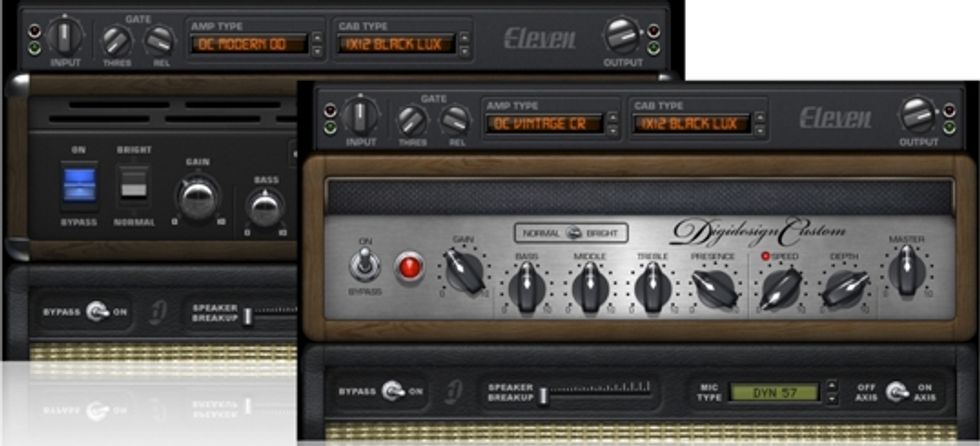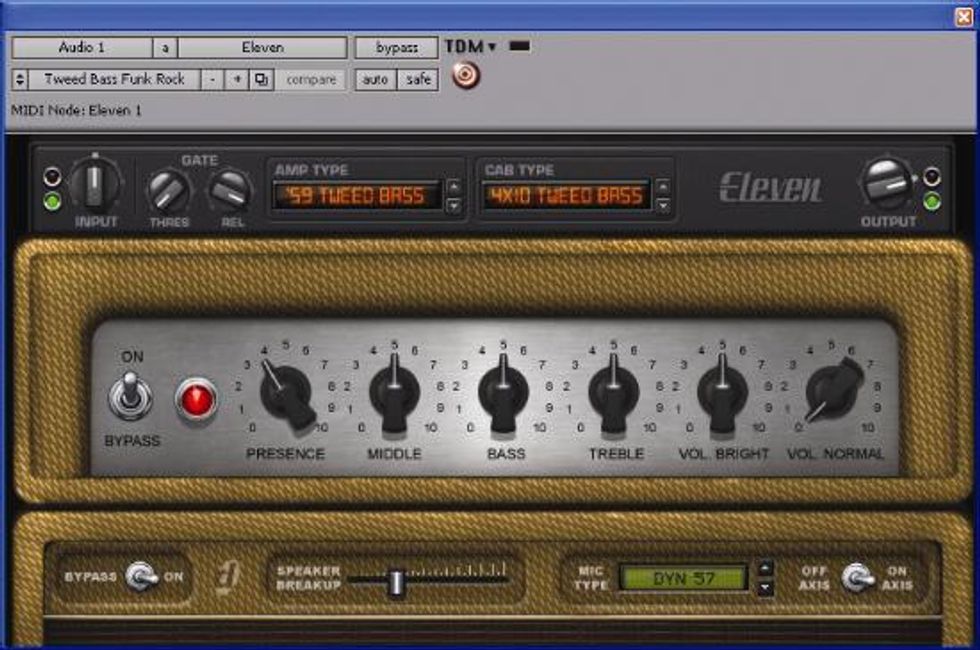Eleven puts expertly modeled amps at your fingertips
I feel fortunate that I grew up playing good amps. I’ve owned Music Mans, Fenders, Boogies, Polytones, Gibsons and Magnatones. I’m also fortunate enough to have recorded some of my favorite guitarists, which has helped me become accustomed to good amp sounds in the studio. With that in mind, I’ve used amp modeling plug-ins that simply didn’t cut it. However, there are a few on the market that can not only sound good, but go where traditional amps can’t. Digidesign’s Eleven qualifies as one of these.
 |
Let’s leave the technical details for later and jump right into the amps. Eleven comes with 12 basic amp types, each modeled after original examples discovered and analyzed by Digidesign. There’s a spate of the expected Fender, Vox and Marshall models – ranging from a ‘64 Fender Deluxe Reverb to a ‘69 Marshall Super Lead head – but there’s also some cool suprises inside. There’s the ‘85 M-2 Lead, modeled from a 1985 Mesa/Boogie Mark IIc+; a ‘92 Treadplate with Modern and Vintage channels from a ‘92 Mesa/Boogie Dual Rectifier head; and a ‘89 SL-100 Drive from an ‘89 Soldano SLO-100 Super. Digidesign has also included a few custom creations – the DC Modern Overdrive is based on a JCM800 but features more bottom, more gain stages, a bright switch and Fender-style tremolo. The DC Vintage Crunch is based on a tweed-era Deluxe, but features more gain and a Bright switch; it also packs in the tone stack and tremolo of a blackface Deluxe Reverb, making it one of Eleven’s most versatile models.
If you’re new to the world of plug-ins, you’ll need a USB Smart Key and an iLok account to run Eleven. It’s available as a TDM or LE (RTAS) version, and can be run as TDM on Pro Tools HD systems and as RTAS and AudioSuite on LE and M-Powered setups. Installation is like any other modern plugin: simply download the installer from the Digidesign website (digidesign.com) and run through the Eleven setup.
Dialing In
Eleven’s interface is quite easy to use. You likely know what the typical amp controls do (Bass, Middle, Treble, etc.), so I’ll bypass those and focus on the interface and “extras.”
 |
At the top of the plug-in is the Master Section, with settings that remain even when switching amps. The Input knob at the top left provides input trim/boost from -18dB to +18dB. Set this level when first plugging in, whether you’re playing it live or applying it to prerecorded tracks. There are Input Clip and LED meters beside the Input knob, plus a Noise Gate with THRES (threshold) and REL (release) knobs. The actual release range is from 10 ms to 3000 ms, allowing for adjustments in sensitivity. The Amp Type selector is a dropdown menu that allows you to choose from among the 16 available amp types (which includes multiple channels on selected models). Using the up and down arrow keys steps you through your choices quickly.
The Cab Type selector operates like the Amp Type dropdown, offering up a full palette of choices: 1x12 Black Panel Lux, 1x12 Tweed Lux, 2x12 AC Blue, 2x12 Black Panel Duo, 4x12 Tweed Bass, 4x12 Classic 30 and 4x12 Green 25W. This is a good time to mention that some of the selected amps are combo amps (such as the Tweed Lux) and the proper cabinet will be set as the default factory selection. That said, you can easily mix and match with Eleven, choosing to put a 4x12 Tweed Bass cab with a Soldano head, or any other combination that makes your heart beat faster.
The Amp Controls section is where you dial up tones from each selected model. Each amp model has its own realistic layout, such as Speed and Depth for Tremolo, and so on. As you might imagine, these controls all respond differently based upon the type of amp selected. Playing with the Master Volume is an adventure with Eleven; with the level near zero, you can get the tone of the preamp without any coloration or distortion from the power amp – for example, rolling down the Master on the SL-100 leaves you with a perfect model of Soldano’s SP-77 preamp. Additionally, the Amp Bypass switch lets you sidestep the amp model when selected, leaving the only cabinet and mic settings in effect. By doing so, a single Eleven head can be used with multiple cabinets for a blend of sound (more on this later). The same applies in the Cabinet Section. The Cabinet Bypass lets you bypass the cabinet and microphone processing, giving you the flexibility to run your sound out to external cabinets for reamping, to not use the section at all or bus it out to other Elevens. Next to the Bypass button sits the Speaker Breakup slider, which allows you to add some additional distortion in the form of smooth sounding cone breakup. The slider range is from 1-10 and offers a little extra crunch when needed.
The Mic Type selector allows you to choose from eight different mics to mic your virtual cabinet: a Ribbon 121, Condenser 414, Condenser 87, Condenser 67, Dynamic 421, Dynamic 409, Dynamic 57 and a Dynamic 7. The Mic Axis switch lets you toggle between on-axis and off-axis sound. All of the mic modeling was done with close mic’ed cabinets to avoid any room tone – something that can always be added later.
"What I like best about Eleven is the “sponginess” you get while playing it. You can play light for a clean sound, but when you dig in there’s that grit you get with tube amps – it was particularly evident while playing through the Fender and Vox models."
Plug It In
Digidesign noted that all the amps and cabinets were modeled with consideration given to things such as signal path, cabinet resonance, power amp sag, ghost notes, cone breakup and even input stage characteristics. While that all sounds fine in print, it’s plugging in that really puts Eleven to the test.
| |||||||||
There were lots of winning tones to be had, but I really enjoyed the mean distortion and creamy sound of the 4x12 Classic 30 cabinet with heads like the ‘89 SL100 and the DC Modern Overdrive. There are so many tonal options available because each mic and cabinet can bring their own vibe to the party. As a producer, it’s exceptionally easy to find a sound that fits a track, instead of having the track fit the sound.
One of the great things about plug-ins is their flexibility. Eleven can be run on a mono track and left as such – if you bypass or remove the plug-in, you are left with the dry signal. But by creating two or more aux inputs and assigning Eleven to them, you can build a custom blend of cabinets. Using the first amp as the head, simply select the Cabinet Bypass. Next, use the Amp Bypass on the additional plug-ins you’ve bussed to the head and then select your chosen cabinets and create a blend, panning and adjusting the volume to create a good balance. The cabinet bypass also allows the use of different speaker simulation plug-ins – such as TL Space – giving you total control over your chain.
Another option Eleven opens up is creating a mixture of amps. By bypassing the original amp channel and running the other Elevens as normal, not bypassing the amp or cabs, you could choose to have a blazing JCM800 on the left and a crunchy Boogie on the right. By placing Digidesign’s DigiRack Time Adjuster plug-in (which compensates for latency) after each amp, you can then play around with both phase and time, increasing your sonic options.
Eleven also allows for automation of all parameters. I found this especially useful for things like turning up the Mic Volume on the ‘59 Tweed Lux during solos, then backing it down during verses. This sidesteps having to call up separate plug-ins, and I was even able to easily assign the plug-in to my Command 8 controller and do it with fader control. Taking it a step further, some players are using a small control surface and a laptop to run Eleven onstage (see sidebar), showcasing its sheer versatility.
The Final Mojo
Overall, I like the tones, playability and control that Eleven offers. It clearly shows that amp modeling has come a long way, and it should be considered a powerful tool for both the studio and live scenarios. The only downside is that you need Pro Tools to run it – something that limits its overall user base. That said, if you’re already running Pro Tools, I cannot recommend Eleven enough.
Buy if...
you want a good sounding, flexible amp plug-in with some choice models
Skip if...
you don’t own Pro Tools
Rating...
MSRP TDM, RTAS Audiosuite $595 RTAS Audiosuite $395- Digidesign - digidesign.com |
Our expert has stated their case, now we want to hear yours. Share your comments and ratings below.
